Software Defined Networking and Dijkstras Algorithm Presented by

Software Defined Networking and Dijkstra’s Algorithm Presented by Prof. Jehn-Ruey Jiang Department of Computer Science & Information Engineering National Central University October 24, 2014

Outline � � � Software-Defined Networking (SDN) ³ Overview ³ History ³ Open. Flow ³ Google’s WAN B 4 ³ Languages ³ Simulators and Emulators Extended Dijkstra’s Algorithm ³ Applications ³ Simulations Summary 2

Outline � � � Software-Defined Networking (SDN) ³ Overview ³ History ³ Open. Flow ³ Google’s WAN B 4 ³ Languages ³ Simulators and Emulators Extended Dijkstra’s Algorithm ³ Applications ³ Simulations Summary 3

The Megatrend in the Computer Industry App Specialized Applications Specialized Operating System Open Interface Windows (OS) or Linux or Mac OS Open Interface Specialized Hardware Microprocessor Vertically integrated Closed, proprietary Slow innovation Small industry Horizontal Open interfaces Rapid innovation Huge industry 4 Source: Dr. Jennifer Rexford’s presentation

The Same Trend in the Network Industry? App Open Interface Specialized Features Control Plane Specialized Control Plane Control or Plane Open Interface Merchant Switching Chips Specialized Hardware Vertically integrated Closed, proprietary Slow innovation Horizontal Open interfaces Rapid innovation 5 Source: Dr. Jennifer Rexford’s presentation

Software-Defined Networking (SDN) App (e. g. , network virtualization) App (e. g. , network management) Northbound API Controller (e. g. , NOX/POX, Floodlight, etc. ) Southbound API (Open. Flow) Packet Forwarding Packet Forwarding 6 Source: Dr. Shie-Yuan Wang’s Presentation

Outline � � � Software-Defined Networking (SDN) ³ Overview ³ History ³ Open. Flow ³ Google’s WAN B 4 ³ Languages ³ Simulators and Emulators Extended Dijkstra’s Algorithm ³ Applications ³ Simulations Summary 7

Software Defined Networking History ~2004: Research on new management paradigms RCP, 4 D [Princeton, CMU, …. ] SANE, Ethane [Stanford/Berkeley] 2008: Software-Defined Networking (SDN) NOX Network Operating System [Nicira] Open Flow switch interface [Stanford/ Nicira] 2011: Open Networking Foundation Board: Google, Yahoo, Verizon, DT, Microsoft, Facebook, NTT Members: Cisco, Juniper, HP, Dell, Broadcom, IBM, …. . Current Google is using SDN in its private WAN B 4 Many commercialized SDN products Source: Dr. Marco Cello’s presentation 8

Software Defined Networking History Biography • Born in Bedford, England on April 7, 1963 • Obtained bachelor's degree from the University of Leeds in 1986 • Obtained master's degree in 1992 and Ph. D in 1995 from the University of California at Berkeley • Became faculty director of the Clean Slate Program at Stanford University in 2006 • Casado, Mc. Keown and Shenker co-founded Nicira Networks in 2007 • Mc. Keown and Shenker co-founded the Open Networking Foundation (ONF) in 2011 • Nicira was acquired by VMWare for $1. 26 billion in July 2012 Nick Mc. Keown Source: http: //en. wikipedia. org/wiki/Nick_Mc. Keown 9

Open Networking Foundation • The Open Networking Foundation (ONF) is a nonprofit organization, founded by Deutsche Telekom, Facebook, Google, Microsoft, Verizon, and Yahoo! on March 21, 2011. • Its purpose is to improve networking through softwaredefined networking (SDN) and standardizing the Open. Flow protocol and related technologies. https: //www. opennetworking. org/ 10

Open Networking Foundation Member Listing 11 https: //www. opennetworking. org/membership/member-listing

Outline � � � Software-Defined Networking (SDN) ³ Overview ³ History ³ Open. Flow ³ Google’s WAN B 4 ³ Languages ³ Simulators and Emulators Extended Dijkstra’s Algorithm ³ Applications ³ Simulations Summary 12

SDN Architecture Source: Open Networking Foundation What paper, 2012 13

Open. Flow Controller & Switch Source: Open Networking Foundation What paper, 2012 14

Flow Table Entry Rule Action Statistics Packet + byte counters 1. Forward packet to port(s) 2. Encapsulate and forward to controller 3. Drop packet 4. Send to normal processing pipeline Switch MAC In Port src MAC dst Eth type VLAN ID IP Src IP Dst Source: Dr. Mc. Keown’s presentation IP Prot TCP sport TCP dport 15

Flow Table Process Example A Mei e-Gate 16

Flow Table Process Example (cont. ) A Mei Name Attribute A Mei Interorbital Mouth size Width ……. … Jessica … … … Iris … … . . . XXX·XXX . . . … … XXX·XX … … … 17

Name. Example Attribute ……. Flow Table Process (cont. ) A Mei Interorbital Width Mouth size … Jessica … … … Iris … … . . . XXX·XXX . . . … … XXX·XX … A… Mei … e-Gate 18

Flow Table Process 19

Open. Flow Versions n n n 2009 n Published Open. Flow Switch Specification 1. 0 – Dec. 31 2011 n Published Open. Flow Switch Specification 1. 1 – Feb. 28 n Published Open. Flow Switch Specification 1. 2 – Dec. 5 2012 n Published Open. Flow Switch Specification 1. 3. 0 – Jun. 25 n The Open. Flow 1. 3. X is Long Term Support Vision (LTS Vision) n Published Open. Flow Switch Specification 1. 3. 1 – Sep. 6 2013 n Published Open. Flow Switch Specification 1. 3. 2 – Apr. 25 n Published Open. Flow Switch Specification 1. 3. 3 – Sep. 27 n Published Open. Flow Switch Specification 1. 4 – Oct. 14 2014 n Published Open. Flow Switch Specification 1. 3. 4 – Mar. 27 20 n Open. Flow Switch Specification 1. 5 to be published at the end of 2014

SDN Controllers 21

Comparison Among The Controllers R. Khondoker, A. Zaalouk, R. Marx, K. Bayarou, “Feature-based Comparison and Selection of Software Defined Networking (SDN) Controllers, ” In Computer Applications and Information Systems (WCCAIS), IEEE, 2014 22

Outline � � � Software-Defined Networking (SDN) ³ Overview ³ History ³ Open. Flow ³ Google’s WAN B 4 ³ Languages ³ Simulators and Emulators Extended Dijkstra’s Algorithm ³ Applications ³ Simulations Summary 23

Google Search Chrome Google Drive Gmail Google Plus Google map 24

� User base ³ ³ ³ � Google services are worldwide: over 55 countries and 112 languages Data Growth ³ ³ ³ � World population: 6. 676 billion people (June’ 08, US Census est. ) Internet Users: 1. 463 billion (>20%) (June’ 08 Nielsen/ITU) Google Search: More than Billion Searches Every Day Geographical Distribution ³ � Google Networks Scales Web expands/changes: billions of new/modified pages every month Every few hours Google craw/refresh more than entire Library of Congress You. Tube gains over 131, 518, 242, 460 hours of video every minute, 4+ billion views every day Latency Challenge ³ ³ Speed of Light in glass: 2 x 10^8 m/s = 2, 000 km/10 ms “Blink of an eye response” 100 The statistics=are fromms Google company 25

ATLAS 2010 Traffic Report Posted on Monday, October 25 th, 2010| Bookmark on del. icio. us “Google Sets New Internet Traffic Record, ”by Craig Labovitz 26

Google’s WAN B 4 � � Using Software Defined Networking (SDN) principles Using Open. Flow Supporting standard routing protocols Centralized Traffic Engineering (TE) S. Jain, et. al. , “B 4, Experience with a Globally-Deployed Software Defined WAN, ” ACM SIGCOMM conference, 2013 27

Google’s WAN B 4 (cont. ) � Traditional WAN Routing ³ ³ � Treat all bits the same 30% ~ 40% average utilization Centralized Traffic Engineering (TE) ³ ³ Drive links to near 100% utilization Fast, global convergence for failures 28

B 4 Sample Utilization The statistics are from Google company 29

Google’s WAN B 4 History The statistics are from Google company 30

Outline � � � Software-Defined Networking (SDN) ³ Overview ³ History ³ Open. Flow ³ Google’s WAN B 4 ³ Languages ³ Simulators and Emulators Extended Dijkstra’s Algorithm ³ Applications ³ Simulations Summary 31

Frenetic � Frenetic is introduced as a high-level language to program the controller to manage switches in the SDN network. 32

Pyretic � Based on Frenetic and Python, Pyretic is introduced as an SDN programming language or platform that raises the level of abstraction. Pyretic � Python + Frenetic = Pyretic 33

Pyretic (cont. ) � � It allows programmers to focus on how to specify a network policy at high-level abstraction. Pyretic hides low-level details by allowing programmers to express policies as compact, abstract functions that take a packet as input, and return a set of new packets. 34

Outline � � � Software-Defined Networking (SDN) ³ Overview ³ History ³ Open. Flow ³ Google’s WAN B 4 ³ Languages ³ Simulators and Emulators Extended Dijkstra’s Algorithm ³ Applications ³ Simulations Summary 35

Mininet � Mininet is an open source network emulator that supports the Open. Flow protocol for the SDN architecture. It is one of the most popular tools used by the SDN research community. 36

Mininet Features � � � It's fast - starting up a simple network takes just a few seconds. This means that your run-editdebug loop can be very quick. You can create custom topologies: a single switch, larger Internet-like topologies, the Stanford backbone, a data center, or anything else. You can run real programs: anything that runs on Linux is available for you to run, from web servers to TCP window monitoring tools to Wireshark. 37

Mininet Features (cont. ) � � � You can run Mininet on your laptop, on a server, in a VM, on a native Linux box (Mininet is included with Ubuntu 12. 10+!), or in the cloud (e. g. Amazon EC 2. ) You can share and replicate results: anyone with a computer can run your code once you've packaged it up. Mininet is an open source project, so you are encouraged to examine its source code on https: //github. com/mininet, modify it, fix bugs, file issues/feature requests, and submit patches/pull requests. Git. Hub -https: //github. com/mininet/wiki/Introduction-to-Mininet 38

Esti. Net Simulator/Emulator � � Esti. Net combines the advantages of both the simulation and emulation approaches without their respective shortcomings. Esti. Net uses tunnel network interfaces to automatically intercept the packets exchanged by two real applications and redirect them into the Esti. Net simulation engine. 39

Esti. Net Simulator/Emulator (cont. ) � Esti. Net’s GUI can be used to easily set up and configure a simulation case and be used to observe the packet playback of a simulation run. 40

A Comparison of Network Simulators Shie-Yuan Wang, Chih-Liang Chou, Chun-Ming Yang, ” Esti. Net Open. Flow Network Simulator and Emulator, ” 41 IEEE Communications Magazine, 2013

Outline � � � Software-Defined Networking (SDN) ³ Overview ³ History ³ Open. Flow ³ Google’s WAN B 4 ³ Languages ³ Simulators and Emulators Extended Dijkstra’s Algorithm ³ Applications ³ Simulations Summary 42

Edsger Wybe Dijkstra • Dijkstra was born in Rotterdam, Netherlands. • He received the 1972 Turing Award for fundamental contributions to developing programming languages. • In 2002, he received the ACM PODC Influential Paper Award in distributed computing for his work on self-stabilization of program computation. This annual award was renamed the Dijkstra Prize the following year, in his honor. (1930~2002) 43

Dijkstra’s shortest path algorithm is a 20 -mimute invention while drinking coffee � “One morning I was shopping in Amsterdam with my young fiancée, and tired, we sat down on the café terrace to drink a cup of coffee and I was just thinking about whether I could do this, and I then designed the algorithm for the shortest path. As I said, it was a 20 -minute invention. In fact, it was published in 1959, three years later. ” Thomas J. Misa (Editor), "An Interview with Edsger W. Dijkstra, " Communications of the ACM 53 (8): 41– 47, 2010. 44

Dijkstra's Algorithm � � � Conceived by computer scientist Edsger Dijkstra in 1956, published in 1959, is a graph search algorithm. Solves the single-source all-destination shortest path problem for a graph with non-negative edge path costs, producing a shortest path tree. This algorithm is often used in routing and as a subroutine in other graph algorithms. http: //en. wikipedia. org/wiki/Dijkstra%27 s_algor 45

Outline � � � Software-Defined Networking (SDN) ³ Overview ³ History ³ Open. Flow ³ Google’s WAN B 4 ³ Languages ³ Simulators and Emulators Extended Dijkstra’s Algorithm ³ Applications ³ Simulations Summary 46

Extending Dijkstra’s Algorithm 47
![Node Weight & Edge Weight � � The node weight nw[v] of v is Node Weight & Edge Weight � � The node weight nw[v] of v is](http://slidetodoc.com/presentation_image_h2/7044c32ac23cf46e586e04c323e4c07f/image-48.jpg)
Node Weight & Edge Weight � � The node weight nw[v] of v is defined according to Eq. (1) The edge weight ew[e] of e is defined according to Eq. (2). 48

Outline � � � Software-Defined Networking (SDN) ³ Overview ³ History ³ Open. Flow ³ Google’s WAN B 4 ³ Languages ³ Simulators and Emulators Extended Dijkstra’s Algorithm ³ Applications ³ Simulations Summary 49

End-to-End Routing 50

Multicast 51

Load Balancing Open. Flow Controller Openvswitch Server Hosts Load Balancer http: //docwiki. cisco. com/wiki/Cisco_ACE_4700_Series_Appliance_Quick_Start_Guide, _Release_A 3( 52 1. 0)_--_Configuring_Server_Load_Balancing

Outline � � � Software-Defined Networking (SDN) ³ Overview ³ History ³ Open. Flow ³ Google’s WAN B 4 ³ Languages ³ Simulators and Emulators Extended Dijkstra’s Algorithm ³ Applications ³ Simulations Summary 53

The Abilene Network Core Topology � � � The Abilene network is a highperformance backbone network suggested by the Internet 2 project in the late 1990 s. It connects 11 regional sites or nodes across the United States. It has 10 Gbps connectivity between neighboring nodes and 100 Mbps connectivity between a host and a node. Historical Abilene Connection Traffic Statistics, http: //stryper. uits. iu. edu/abilene/, last accessed in March 2014. 54

Simulation Settings for Routing � Setting up the Abilene topology in Mininet for routing from the green client to the red client 55

Simulation Settings for Routing (cont. ) � � � We use Iperf as a testing tool to generate TCP data streams in our simulation. The testing time for every testing case is 1000 seconds. The Iperf tool reports the average TCP bandwidth between a client and the server, and we use the packet size of 53 bytes to derive the average end-to-end latency. 56

Simulation Results for Routing 57

Simulation Setting for Multicasting � Topology Setting 58
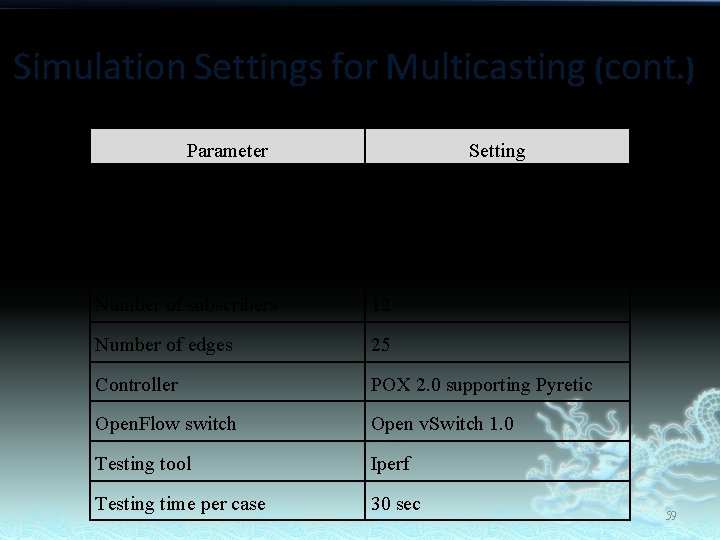
Simulation Settings for Multicasting (cont. ) Parameter Setting Number of controller 1 Number of switches 11 Number of publisher 1 Number of subscribers 12 Number of edges 25 Controller POX 2. 0 supporting Pyretic Open. Flow switch Open v. Switch 1. 0 Testing tool Iperf Testing time per case 30 sec 59

Simulation Results for Multicasting � The BFST 60
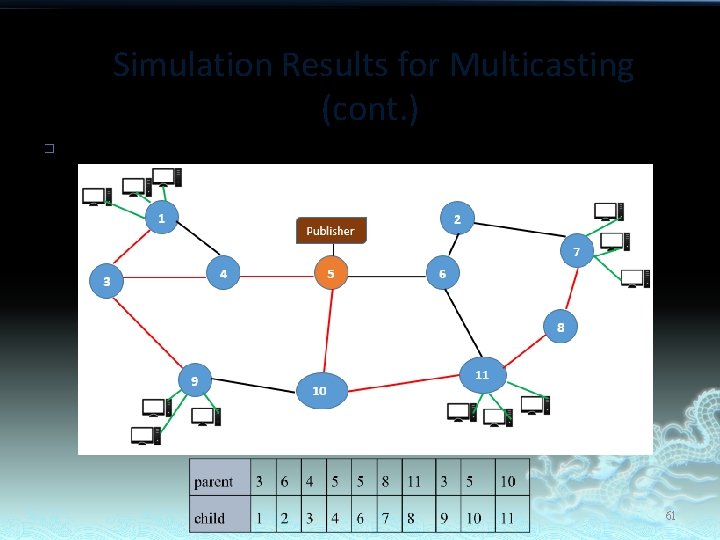
Simulation Results for Multicasting (cont. ) � The DSPT 61

Simulation Results for Multicasting (cont. ) � The EDSPT parent 4 6 4 5 5 2 11 10 5 child 1 2 3 4 6 7 8 9 6 10 11 62
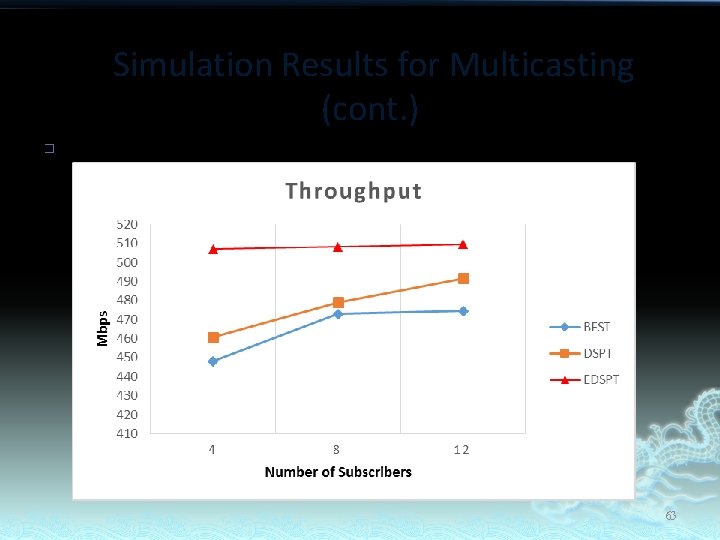
Simulation Results for Multicasting (cont. ) � Throughput 63
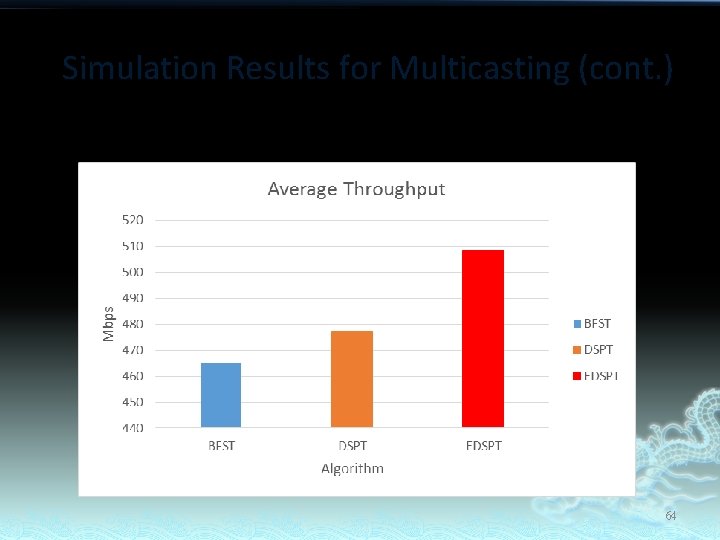
Simulation Results for Multicasting (cont. ) Average Throughput 64
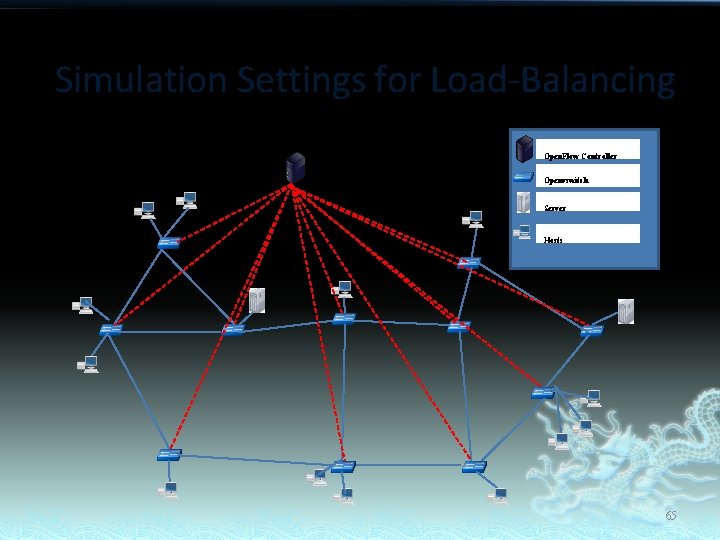
Simulation Settings for Load-Balancing Open. Flow Controller Openvswitch Server Hosts 65
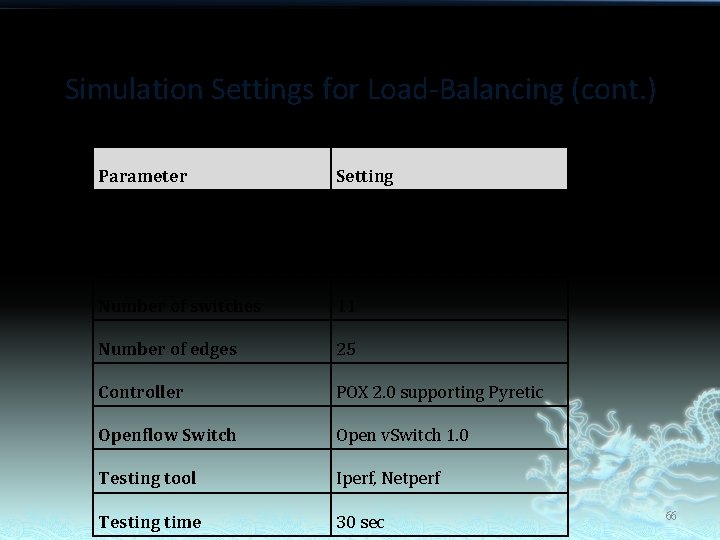
Simulation Settings for Load-Balancing (cont. ) Parameter Setting Bandwidth on edges 1 Gbps Number of server 2 Number of switches 11 Number of edges 25 Controller POX 2. 0 supporting Pyretic Openflow Switch Open v. Switch 1. 0 Testing tool Iperf, Netperf Testing time 30 sec 66
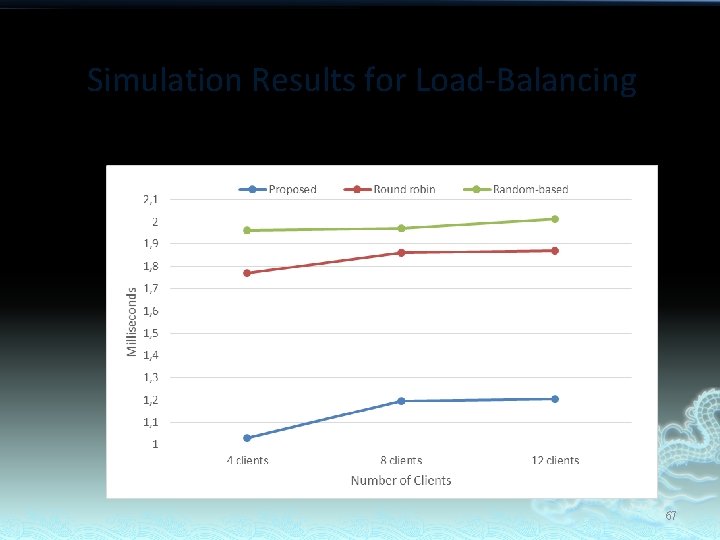
Simulation Results for Load-Balancing End-to-End Latency 67
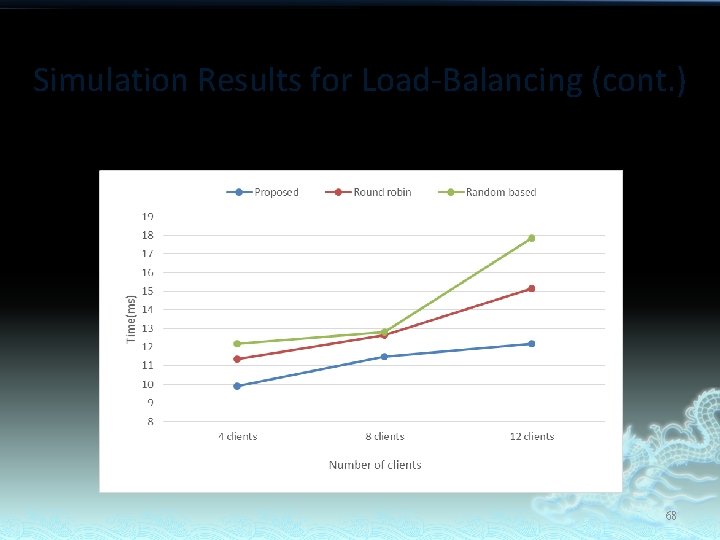
Simulation Results for Load-Balancing (cont. ) Response Time 68
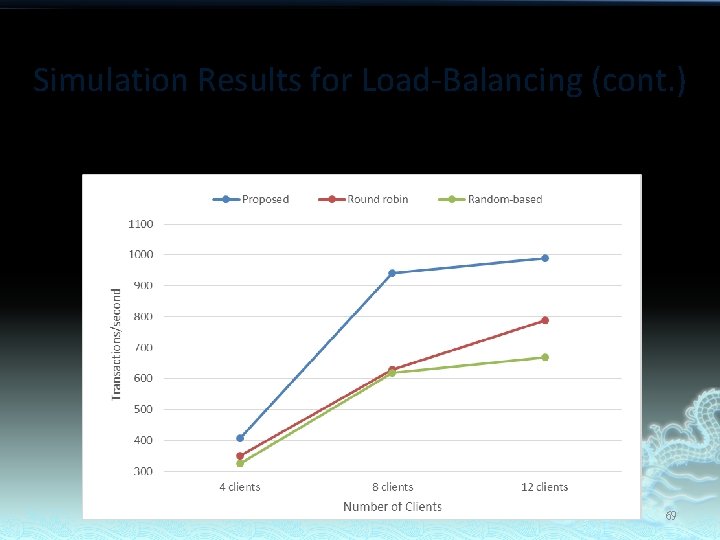
Simulation Results for Load-Balancing (cont. ) Total Transactions to Servers 69
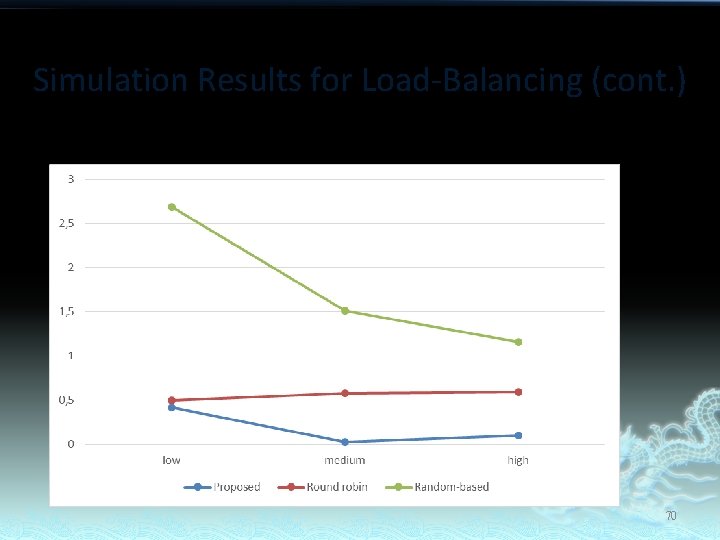
Simulation Results for Load-Balancing (cont. ) Variation Loads on Server 70
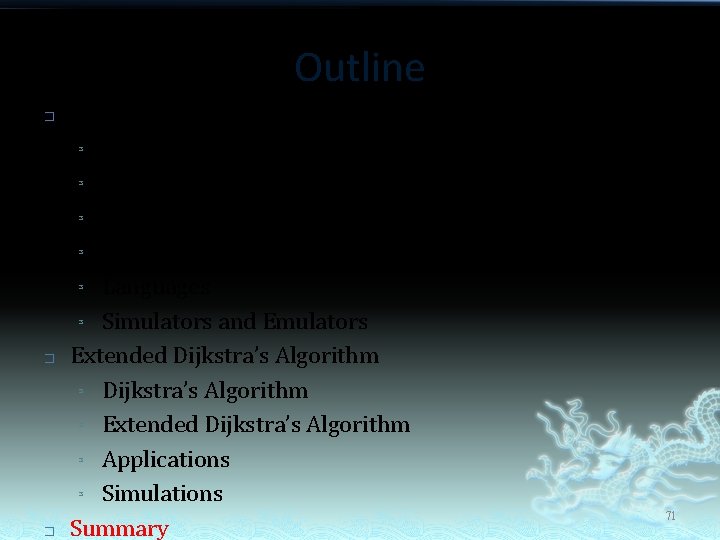
Outline � � � Software-Defined Networking (SDN) ³ Overview ³ History ³ Open. Flow ³ Google’s WAN B 4 ³ Languages ³ Simulators and Emulators Extended Dijkstra’s Algorithm ³ Applications ³ Simulations Summary 71
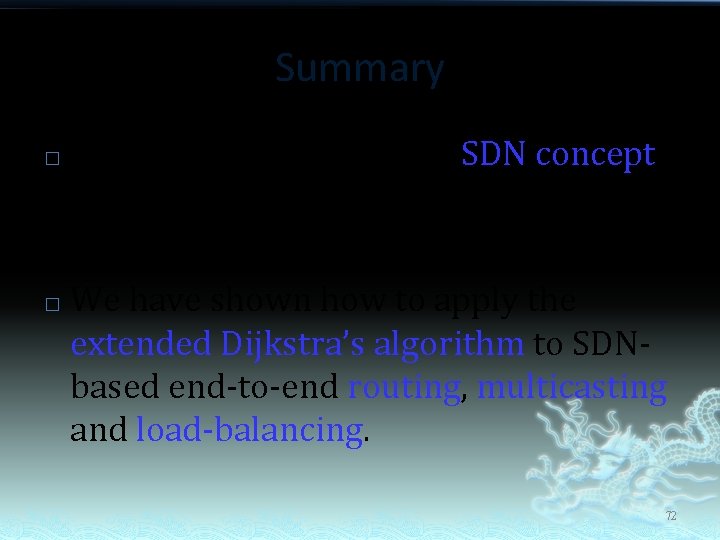
Summary � � We have introduced the SDN concept and its related technologies. We have shown how to apply the extended Dijkstra’s algorithm to SDNbased end-to-end routing, multicasting and load-balancing. 72
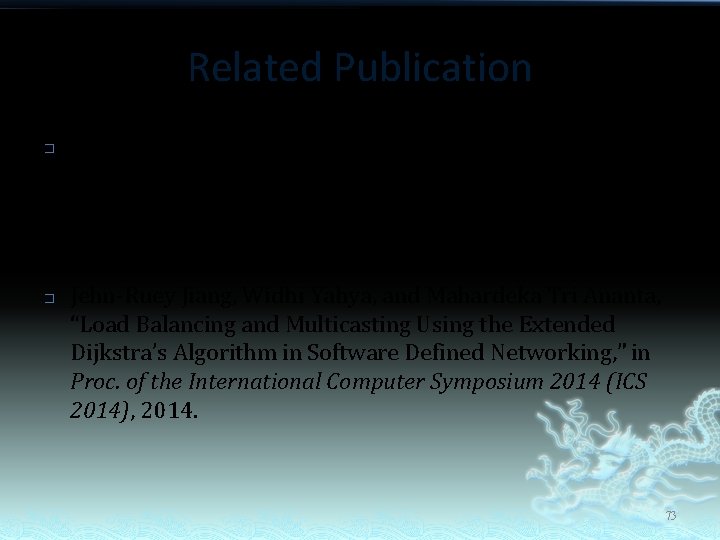
Related Publication � � Jehn-Ruey Jiang, Hsin-Wen Huang, Ji-Hau Liao, and Szu. Yuan Chen, “Extending Dijkstra’s Shortest Path Algorithm for Software Defined Networking, ” in Proc. of the 16 th Asia. Pacific Network Operations and Management Symposium (APNOMS 2014), 2014. Jehn-Ruey Jiang, Widhi Yahya, and Mahardeka Tri Ananta, “Load Balancing and Multicasting Using the Extended Dijkstra’s Algorithm in Software Defined Networking, ” in Proc. of the International Computer Symposium 2014 (ICS 2014), 2014. 73

Thank You! 74
- Slides: 74